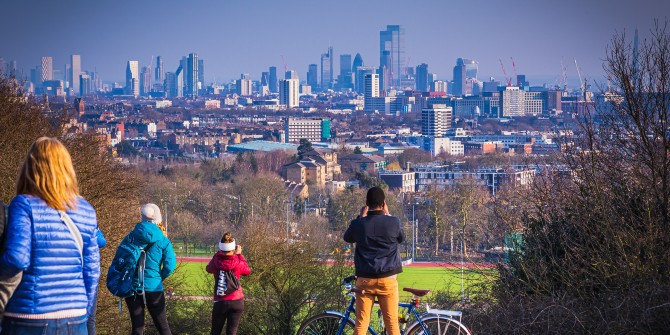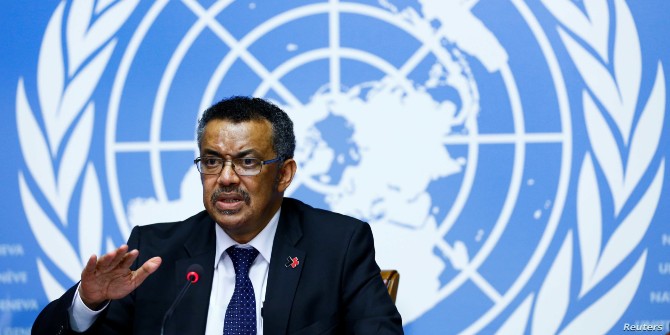The instruction to work from home has had far-reaching effects on the UK capital. Tony Travers (LSE) sets out the challenges facing the centre of London, and Matthew Dillon and Laetitia Lucy (Arup) say it needs to become a sustainable, healthy and green urban centre, with a bigger residential population.
As we begin to take tentative steps out of the third national lockdown, we can reflect on the anniversary of near-full time home working for many of London’s office workers. Many of these individuals will not have set foot in their place of work, or indeed in central London, since March 2020. And many may never do so again. Now, meeting a client or supplier, and even attending a job interview virtually is the norm, and returning to face-to-face working seems somewhat novel. Behavioural scientists often advise that it takes six weeks to form new, long lasting habits; after a year, one might expect home working to be firmly entrenched.
However, there are signs of a potential gradual return to the office. Last summer UK employers were extremely open and adaptable to continued flexible working. By July 2021, they might not be quite so laissez-faire, with a mixture of trust and productivity at the forefront of employers’ minds. Some employers have come forward and expressed their will to get their people back to the office. At the same time, many employees will have suffered mental health impacts as a result of a winter in virtual isolation from both friends and colleagues. For many, including a majority of those that responded to the surveys we refer to in this report, a balance between home and office-based working appears to be emerging as the optimum.
We may have employers having to work very hard to entice their employees back to the office
In this report we model scenarios to take account of the uncertainty of future home working. We outline how footfall from office workers has had a significant impact on the hospitality, entertainment and arts and culture industries in their location, undermining the functioning of the Central Activities Zone (CAZ) economic ecosystem. We also assume that the shift in retail habits, accelerated during the pandemic, are structural and do not fully reverse.

For the period since last spring, central London’s loss has, to a certain extent, been outer London’s (and the wider region’s) gain, as office-based employees are more likely to spend their leisure and retail time, and money, closer to where they currently work. A partial return to the CAZ will have an impact on the businesses that survive and thrive in different parts of London, and in due course, on the offer that the capital makes to tourists and visitors.
A full, or near full return could see a resurgent CAZ pick up almost where it left off, with a greater number of individuals making slightly fewer trips, potentially leading to higher spend overall. But it is in the scenarios with widespread home working that a substantial change and reinvention of the CAZ is likely. In this version of the future we may have employers having to work very hard to entice their employees back to the office. We may also have the CAZ suffering initially, and then responding to the lower office worker footfall by evolving the leisure offer, and growing its residential population over time.
All of this would have an impact on London’s built environment and streetscape, as well as its economic, social and environmental outcomes. There would, of course, be opportunities for new companies to move into central London or start up there.
The CAZ must reinvent itself if it is going to adapt to the losses and changes caused by COVID-19 and new ways of working and to avoid a ‘vicious cycle’ of decline setting in. But there are opportunities too and harnessing the positives from these future scenarios is key. As we said in the introduction to our Phase 1 Report, each of these outcomes represents a chance to re-assess the functionality and performance of the CAZ. At this major crossroads for the CAZ, for London, and for society, a vision for the future is necessary, so that we deal with some of the older problems, as well as the challenges of tomorrow, and so that when the CAZ does recover, it will work better for everyone. Policy-makers at all level have choices to make.
Significant interventions are required
In the next two years
Provide immediate support to re-ignite the CAZ ecosystem, and to bring people back:
Act immediately to support industries which rely on face-to-face interaction, especially those in arts and culture.
Understand the extent of the non-health impacts of COVID-19 across London’s diverse population and implement targeted support plans.
Emphasise the benefits of coming into central London through strong marketing campaigns.
Maintain the quality and frequency of London’s important public transport network, including a longer term funding arrangement for TfL.
Reduce the marginal costs of a sustainable visit to the CAZ, through keeping fares low, and deploying part-time season tickets on the national rail network.
Actions to take in the medium- to long-term (2-10 years)
Develop the CAZ as a model of a sustainable, healthy and green urban centre, with a thriving arts, culture, entertainment and hospitality offer:
Deliver a step-change improvement in inclusive and accessible public realm and urban experience with a level of ambition beyond those of previous plans, including new places that bring people closer to nature, provide space for families, recreational facilities close to workplaces and residential locations, active spaces and play.
Provide more pedestrianisation, an ambitious new active travel network, and better cycle parking and change facilities.
Increase the CAZ’s role in hosting arts, culture and festivals with increased funding for grassroots arts and culture that reflects the diversity of London.
Be agile, embrace experimentation, encourage temporary solutions and continue to move with the fast pace of pedestrianisation and the active travel network:
Generate excitement, provide reasons to visit and maintain vibrancy by making temporary solutions the norm.
Promote collaborative spaces through agile public sector regulation, policy and initiatives which help bring forward space suited to joint working and collaboration.
Embrace the flexibility in timings offered by new ways of working to spread footfall around the clock, reducing crowds at certain times, and to make the CAZ more attractive for people after 6pm.
Create greater polycentricity in London by identifying the local centres that may be impacted most, and which could increase levels of office buildings and shared co-working spaces outside of the CAZ.
Strengthen the CAZ’s growth sectors and provide the world’s best environment for collaboration and innovation:
Encourage growth in the emerging sectors, including across technology and life sciences as the bedrock of London’s future growth. This includes providing marketing, space, skills, and incentives to encourage growth.
Provide support for green shoots, innovation, entrepreneurship and re-skilling of Londoners.
Take steps to increase the population of the CAZ:
Grow the number of central London residents through positive strategic and local planning (though not through low quality accommodation or by compromising strategic functions), focussed on Opportunity Areas and re-purposing brownfield sites.
Increase the mixture of housing stock in the CAZ, to encourage more genuinely affordable housing and homes suited to a wider range of people.
Create a shared vision, work in partnership and apply strong leadership:
Create a long term vision for the CAZ.
The GLA needs to take the strategic leadership on the future of the CAZ, working with relevant boroughs and other stakeholders.
Join with other cities to make the case for investment in central areas to government.
Gather data on the fast moving situation, and apply a course correction if necessary.
This post is extracted from an Arup, Gerald Eve and LSE report for the Greater London Authority, The economic future of the Central Activities Zone (CAZ): Phase 2 Report. It represents the views of the authors and not those of the COVID-19 blog, nor LSE, and was prepared for use and reliance by the GLA only. Please see the disclaimer on page 9 of the report.





